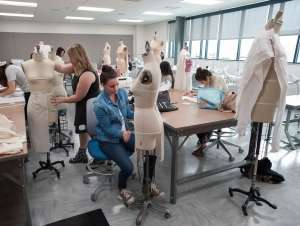Making fashion sustainable

Soon after new designs hit the fashion runways in New York and Paris, knockoffs can appear on sales racks in as little as two weeks, especially in retail outlets geared toward the young consumer on a budget.
While the seasonal clothes are trendy and inexpensive, they are cheaply made and don't last, said Arlesa Shephard (pictured), assistant professor of fashion and textile technology (FTT). This "fast fashion" trend results in throwaway clothes that often end up in landfills while a growing amount of raw material is needed to make replacements.
"What we have now is not sustainable for the long-term future of the planet," she said.
Shephard and Sanjukta Pookulangra, a University of North Texas merchandising and digital retailing professor, are researching a counter trend—the slow fashion movement. Much like the slow food movement, which aims to preserve biodiversity, slow fashion aims to minimize the fossil footprint of clothing manufacturing and improve conditions for garment workers.
"A lot of people focus on one aspect of sustainability, like labor issues or organic fibers or waste caused by textile products," Shephard said. "Over the last decade, more people in the fashion industry have started to realize that this is a broader, more encompassing issue."
While the whole idea behind fashion is introducing something new, Shephard contends that the industry can find ways to make it cost-effective and sustainable. She and Pookulangra are looking at initiatives designers are using to make clothing longer lasting, as well as how retailers are educating consumers on purchasing better-made clothing that extend beyond one season.
Additionally, she said, designers and manufacturers need to be conscious of all their decisions—how dyes are disposed of, what chemicals are used in the finished product, and what factory conditions are like.
"After the Bangladesh garment factory collapse last year (which killed more than 1,000 workers), it really opened people's eyes," she said. "But poor working conditions are not just in that country."
Shephard, who has a background in clothing history and also curates the FTT historic costumes and textile collections, noted that making clothing quickly on the cheap is a relatively recent trend. Until the mid-twentieth century, the majority of the clothes U.S. consumers purchased were made in this country. Garments cost more and people bought less of them. That began to change as manufacturing moved overseas.
"Clothing is one of the only commodities that have actually gone down in price over time, adjusted for inflation," Shephard said.
As part of their research, the two professors completed a case study with fast fashion European retailer H&M to see if and how the company implements the eco-friendly ideas touted in its sustainability study. Already, Shephard and Pookulangra have contributed a chapter on their H&M findings for the book Fast-Fashion Systems: Theories and Applications, edited by Tsan Ming Choi, which will released later in December.
They also have interviewed students from both institutions on consumer perceptions and will test that data against a larger group of people.
"We are hoping for a complete analysis this spring," she said.
So far, the interviews indicate that even though consumers are willing and ready to accept the slow fashion movement, they don't possess adequate knowledge to make informed decisions.
"Young people are diligent about recycling their soda cans and water bottles, but when it comes to fashion, they really don't see it as something to be recycled," Shephard said. "This perception is something that still needs to be addressed. The bottom line is you don't have to be wasteful to be fashionable."
Provided by Buffalo State




















